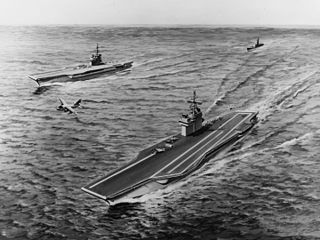 W
WThe Aircraft Carrier (Medium) (CVV) was an American design for a conventional-powered aircraft carrier proposed in the 1970s. It was to be smaller and cheaper than the contemporary nuclear-powered Nimitz class. A single example was planned, but was not built, with further Nimitz-class carriers built instead.
 W
WBaylander (IX-514), ex-YFU-79, was a United States Navy Helicopter Landing Trainer (HLT), billed as the world's smallest aircraft carrier. It served as a practice landing site for helicopter pilots in the United States Navy, Army, Air Force, Marine Corps, Coast Guard, and National Guard.
 W
WUSS Enterprise (CVN-65), formerly CVA(N)-65, is a decommissioned United States Navy aircraft carrier. She was the first nuclear-powered aircraft carrier and the eighth United States naval vessel to bear the name. Like her predecessor of World War II fame, she is nicknamed "Big E". At 1,123 feet (342 m), she is the longest naval vessel ever built. Her 93,284-long-ton (94,781 t) displacement ranks her as the 12th-heaviest carrier, after the ten carriers of the Nimitz class and USS Gerald R. Ford. Enterprise had a crew of some 4,600 service members.
 W
WThe 1969 USS Enterprise fire was a major fire and series of explosions that broke out aboard USS Enterprise on January 14, 1969, off the coast of Pearl Harbor, Hawaii. The fire started when a Zuni rocket detonated under a plane's wing. It spread as more munitions exploded, blowing holes in the flight deck that allowed burning jet fuel to enter the ship. 28 sailors were killed, 314 were injured, 15 aircraft were destroyed, and the total cost of aircraft replacement and shipboard repair was over $126 million. The damage was lessened somewhat by improvements made after the similar 1967 USS Forrestal fire.
 W
WUSS Langley (CV-1/AV-3) was the United States Navy's first aircraft carrier, converted in 1920 from the collier USS Jupiter (AC-3), and also the US Navy's first turbo-electric-powered ship. Conversion of another collier was planned but canceled when the Washington Naval Treaty required the cancellation of the partially built Lexington-class battlecruisers Lexington and Saratoga, freeing up their hulls for conversion to the aircraft carriers Lexington and Saratoga. Langley was named after Samuel Pierpont Langley, an American aviation pioneer. Following another conversion to a seaplane tender, Langley fought in World War II. On 27 February 1942, she was attacked by nine twin-engine Japanese bombers of the Japanese 21st and 23rd Naval Air Flotillas and so badly damaged that she had to be scuttled by her escorts.
 W
WModern United States Navy aircraft carrier air operations include the operation of fixed-wing and rotary aircraft on and around an aircraft carrier for performance of combat or noncombat missions. The flight operations are highly evolved, based on experiences dating back to 1922 with USS Langley.
 W
WUSS Ranger (CV-4) was an interwar United States Navy aircraft carrier, the only ship of its class. As a Treaty ship, Ranger was the first U.S. vessel to be designed and built from the keel up as a carrier. It was relatively small, just 730 ft (222.5 m) long and under 15,000 long tons (15,000 t), closer in size and displacement to the first US carrier—Langley—than later ships. An island superstructure was not included in the original design, but was added after completion.
 W
WUSS Reprisal CV-35 was a planned member of the Essex-class aircraft carrier of World War II. Due to hostilities ending in the Pacific Theater marking the end of World War II, and a number of other veteran Essex-class carriers being available, her construction was cancelled on August 12, 1945 when she was about 52.3% completed. She was launched later that year to clear the slipway and perform bomb damage assessment. Plans were drawn up to complete her as an attack carrier, but the plan was ultimately dropped and she was sold to Boston Metals Co., Baltimore, Maryland for scrap in 1949.
 W
WThe Sea Control Ship (SCS) was a small aircraft carrier developed and conceptualized by the United States Navy under Chief of Naval Operations Elmo Zumwalt during the 1970s. Currently the term refers to naval vessels that can perform similar duties. The SCS was intended as an escort vessel, providing air support for convoys. It was canceled after budgetary cuts to the US Navy.
 W
WUSS United States (CVA-58) was to be the lead ship of a new design of aircraft carrier. On 29 July 1948, President Harry Truman approved construction of five "supercarriers", for which funds had been provided in the Naval Appropriations Act of 1949. The keel of the first of the five planned postwar carriers was laid down on 18 April 1949 at Newport News Drydock and Shipbuilding. The program was canceled in 1949, United States was not completed, and the other four planned carriers were never built.
 W
WThe VSTOL Support Ship (VSS) was a proposed light aircraft carrier design for the United States Navy in the late 1970s that would be smaller and less expensive than the Navy's existing aircraft carriers such as the Nimitz-class. The design would cost one-quarter as much, although the V/STOL aircraft it would carry would have reduced performance. The United States Senate and others supported the design, but it was ultimately rejected by the Navy.
 W
WUSS Wasp (CV-7) was a United States Navy aircraft carrier commissioned in 1940 and lost in action in 1942. She was the eighth ship named USS Wasp, and the sole ship of a class built to use up the remaining tonnage allowed to the U.S. for aircraft carriers under the treaties of the time. As a reduced-size version of the Yorktown-class aircraft carrier hull, Wasp was more vulnerable than other United States aircraft carriers available at the opening of hostilities. Wasp was initially employed in the Atlantic campaign, where Axis naval forces were perceived as less capable of inflicting decisive damage. After supporting the occupation of Iceland in 1941, Wasp joined the British Home Fleet in April 1942 and twice ferried British fighter aircraft to Malta.